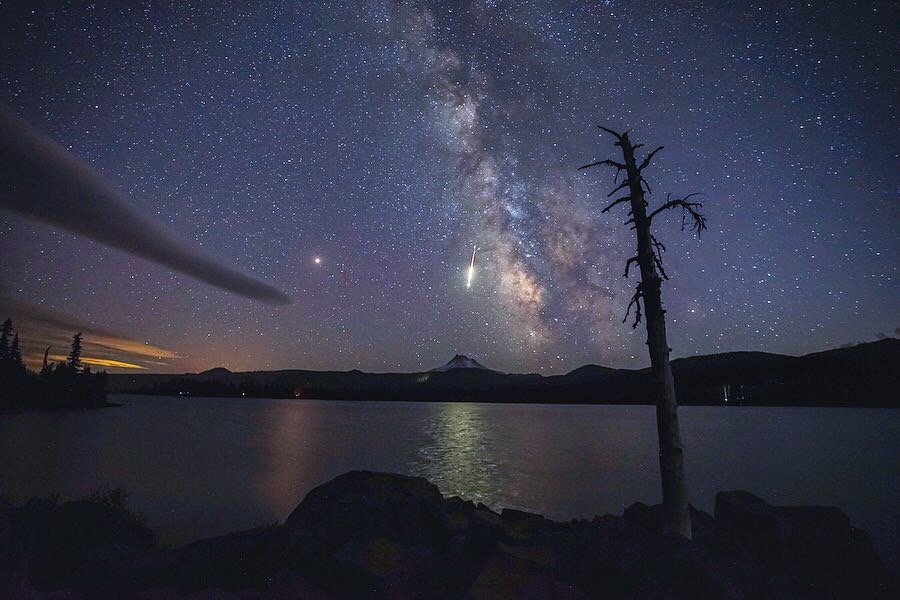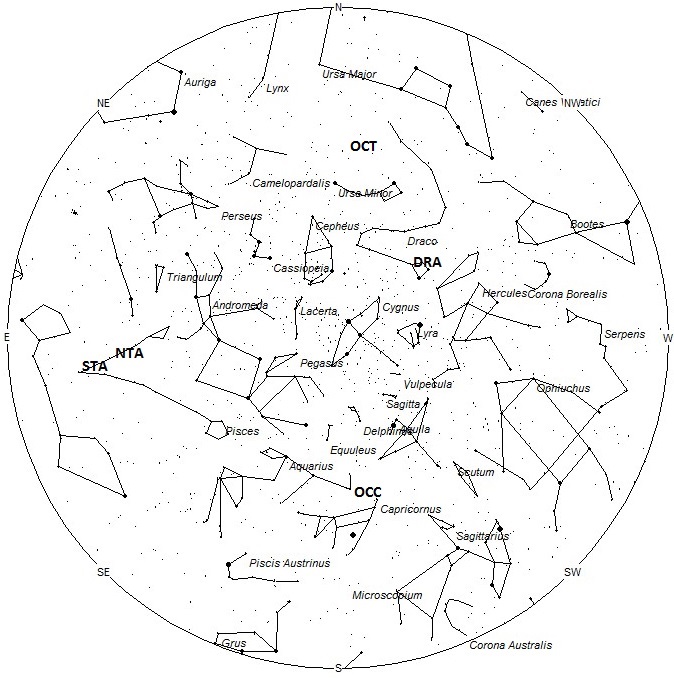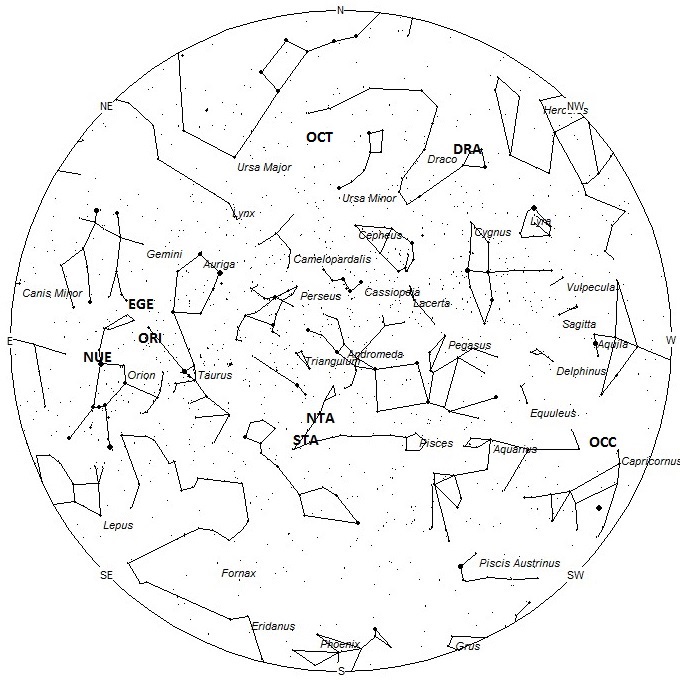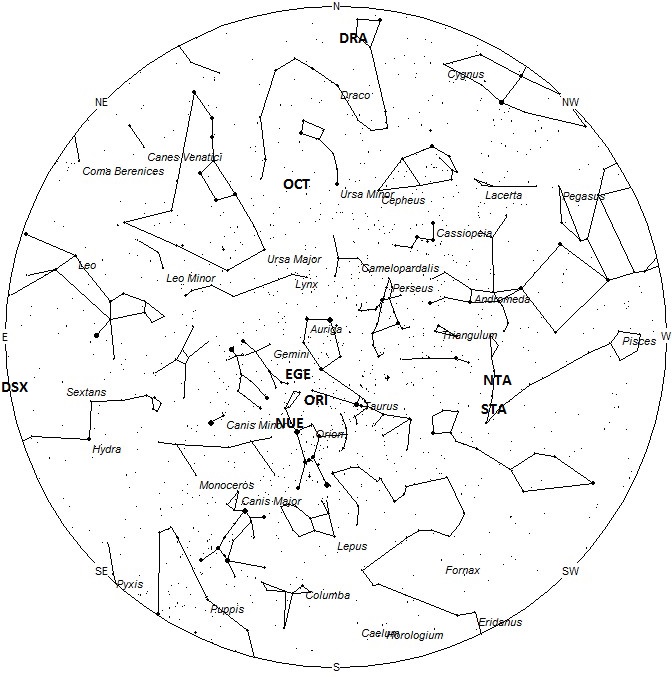
During this period the moon will reach its new phase on Tuesday October 9th. At this time the moon will be located near the sun and will be invisible at night. This weekend the waning crescent moon will rise just before dawn and will not interfere with viewing meteor activity. The estimated total hourly meteor rates for evening observers this week is near 4 for those viewing from the northern hemisphere and 3 for those located south of the equator. For morning observers the estimated total hourly rates should be near 18 as seen from mid-northern latitudes and 13 from the southern tropics. The actual rates will also depend on factors such as personal light and motion perception, local weather conditions, alertness and experience in watching meteor activity. Note that the hourly rates listed below are estimates as viewed from dark sky sites away from urban light sources. Observers viewing from urban areas will see less activity as only the brighter meteors will be visible from such locations.
The radiant (the area of the sky where meteors appear to shoot from) positions and rates listed below are exact for Saturday night/Sunday morning October 6/7. These positions do not change greatly day to day so the listed coordinates may be used during this entire period. Most star atlases (available at science stores and planetariums) will provide maps with grid lines of the celestial coordinates so that you may find out exactly where these positions are located in the sky. A planisphere or computer planetarium program is also useful in showing the sky at any time of night on any date of the year. Activity from each radiant is best seen when it is positioned highest in the sky, either due north or south along the meridian, depending on your latitude. It must be remembered that meteor activity is rarely seen at the radiant position. Rather they shoot outwards from the radiant so it is best to center your field of view so that the radiant lies at the edge and not the center. Viewing there will allow you to easily trace the path of each meteor back to the radiant (if it is a shower member) or in another direction if it is a sporadic. Meteor activity is not seen from radiants that are located far below the horizon. The positions below are listed in a west to east manner in order of right ascension (celestial longitude). The positions listed first are located further west therefore are accessible earlier in the night while those listed further down the list rise later in the night.
These sources of meteoric activity are expected to be active this week..
With comet 21P/Giacobini-Zinner just past perihelion, one would think 2018 may be a good year for the October Draconids (DRA). Experts have studied the conditions for this year and have come to the conclusion that nothing exceptional will occur. Still, no one is 100% certain of this so I would advise all observers with clear skies on the evening of October 8th to watch for at least an hour after the sky becomes sufficiently dark. Any notable activity would most likely occur between 23:00 UT on October 8 to 01:00 UT on October 9. These times favor the Atlantic area including western Europe, northwestern Africa, northeastern South America, and eastern North America. For those located in the eastern time zone of North America, this timing is equivalent 7:00pm to 9:00pm EDT. Observers outside this area should still observe as negative reports of activity are important too. Activity is only expected on this one night. The radiant lies at 17:32 (263) +56. This position lies in southeastern Draco, very close to the position occupied by the faint star known as Kuma (nu Draconis). With an entry velocity of 21 km/sec., the average Draconid meteor would be of very slow velocity. These meteors are poorly seen from the southern hemisphere due to the low radiant altitude seen from below the equator.
The October Capricornids (OCC) were discovered in 1972 when a moderate display of bright meteors were seen from Australia. Little has been seen since. These meteors are possibly related to lost comet D/1978 R1 (Haneda-Campos). If the comet still exists it would have reached perihelion in November 2016. The radiant is currently located near 20:28 (307) -09. This position is roughly 4 degrees northeast of the naked eye double star known as Algedi (alpha2 Capricorni). This position is best placed near 2000 local summer time (LST) when the radiant lies highest above the horizon. While this area of the sky is fairly well placed for northern observers, it is much more favorably placed for those south of the equator where it lies much higher in the sky. Like the Daytime Sextantids mentioned below, any observations of these stream (either positive or negative) would be important to our understanding of these streams. Maximum activity was predicted to occur on October 3rd.
The Northern Taurids (NTA) are active from a large radiant located at 01:28 (022) +14. This area of the sky is located in eastern Pisces, just 1 degree south of the 4th magnitude star known as Alpherg (eta Piscium). This position is close to the Southern Taurids so great care must be taken in separating these meteors. You must have the two radiants near the center of your field of view to properly differentiate these sources. The maximum is not expected until early November so current rates would be 1 per hour or less. These meteors may be seen all night long but the radiant is best placed near 0200 LST when it lies on the meridian and is located highest in the sky. With an entry velocity of 28 km/sec., the average Northern Taurid meteor would be of slow velocity.
The Southern Taurids (STA) are active from a large radiant centered near 01:44 (026) +07. This position lies in southeastern Pisces, just 2 degrees south of the 4th magnitude star known as Torcular (omicron Piscium). These meteors may be seen all night long but the radiant is best placed near 0200 LST when it lies on the meridian and is located highest in the sky. Rates at this time should be near 3 per hour regardless of your location. With an entry velocity of 27 km/sec., the average Southern Taurid meteor would be of slow velocity.
The Orionids (ORI) are active from a radiant located at 05:26 (081) +17, which places it in eastern Taurus, 4 degrees southwest of the 3rd magnitude star known as Tianguan (zeta Tauri). This area of the sky is best placed during the last hour before dawn, when it lies highest above the horizon in a dark sky. Current rates would be near 2 per hour no matter your location. With an entry velocity of 67 km/sec., most activity from this radiant would be of swift speed.
The epsilon Geminids (EGE) are active from September 30 through October 25 with maximum activity occurring on October 11. The radiant is currently located at 05:57 (089) +28, which places where the borders of Taurus, Auriga, and Gemini meet. The bright 2nd magnitude star known as El Nath (beta Tauri) lies 6 degrees to the west of the radiant. This area of the sky is best placed in the sky during the last hour before dawn, when it lies highest above the horizon in a dark sky. Current rates should be near 1 per hour from the northern hemisphere and less than 1 as seen from south of the equator. With an entry velocity of 70 km/sec., most activity from this radiant would be of swift speed.
The nu Eridanids (NUE) were co-discovered by Japanese observers using SonotoCo and Juergen Rendtel and Sirko Molau of the IMO. Activity from this long-period stream stretches from August 23 all the way to November 16. A very shallow maximum occurred near September 24. The radiant currently lies at 05:58 (090) +09, which places it in northeastern Orion, only 2 degrees northeast of the 1st magnitude orange star known as Betelgeuse (alpha Orionis). This area of the sky is best seen during the last dark hour before dawn when the radiant lies highest in a dark sky. Current rates are expected to be near 1 per hour during this period no matter your location. With an entry velocity of 67 km/sec., the average meteor from this source would be of swift velocity. Some experts feel that these meteors are early members of the Orionid shower, which peaks on October 22.
The last of the Daytime Sextantids (DSX) are expected to be seen this week. The radiant is currently located at 10:46 (161) -05. This position lies in eastern Sextans, 10 degrees southeast of the 4th magnitude star known as alpha Sextantis. This area of the sky is best placed in the sky during the last hour before dawn, when it lies highest above the horizon in a dark sky. Current rates would be most likely less than 1 per hour no matter your location. Spotting any of this activity would be a notable accomplishment. With an entry velocity of 33km/sec., most activity from this radiant would be of medium-slow speed.
The October Camelopardalids (OCT) are a recent discovery due to an outburst recorded by video cameras in 2005. Activity has occurred every year since and visual observers should be able to detect these meteors. This source is active from October 5-9 with maximum falling on the 6th. The radiant position lies near 11:13 (167) +78. This area of the sky is located in a barren area of extreme northeastern Camelopardalis. The easiest way to pinpoint the radiant is to extend a line eastward from the bottom two stars of the “bowl of the Little Dipper”. Extend another line northward from the “pointers” of the Big Dipper. Where these lines intersect is the location of the radiant. This area of the sky is above the horizon all night long but is best seen during the last dark hour before dawn when the radiant lies highest in a dark sky. Rates are expected to be low except near maximum activity. Due to the location near the northern pole, these meteors are not visible from the southern hemisphere. With an entry velocity of 47 km/sec., the average meteor from this source would be of medium velocity.
20As seen from the mid-northern hemisphere (45N) one would expect to see approximately 10 sporadic meteors per hour during the last hour before dawn as seen from rural observing sites. Evening rates would be near 3 per hour. As seen from the tropical southern latitudes (25S), morning rates would be near 7 per hour as seen from rural observing sites and 2 per hour during the evening hours. Locations between these two extremes would see activity between the listed figures.
The list below offers the information from above in tabular form. Rates and positions are exact for Saturday night/Sunday morning except where noted in the shower descriptions.
| SHOWER | DATE OF MAXIMUM ACTIVITY | CELESTIAL POSITION | ENTRY VELOCITY | CULMINATION | HOURLY RATE | CLASS |
| RA (RA in Deg.) DEC | Km/Sec | Local Summer Time | North-South | |||
| October Draconids (DRA) | Oct 08 | 17:32 (263) +56 | 21 | 19:00 | Var | III |
| October Capricornids (OCC) | Oct 03 | 20:28 (307) -09 | 10 | 22:00 | <1 – <1 | IV |
| Northern Taurids (NTA) | Nov 02 | 01:28 (022) +14 | 28 | 02:00 | 1 – <1 | II |
| Southern Taurids (STA) | Oct 10 | 01:44 (026) +07 | 27 | 02:00 | 3 – 3 | II |
| Orionids (ORI) | Oct 22 | 05:26 (081) +17 | 67 | 05:00 | 2 – 2 | I |
| nu Eridanids (NUE) | Sep 24 | 05:58 (090) +09 | 67 | 06:00 | 1 -1 | IV |
| epsilon Geminids (EGE) | Oct 11 | 05:57 (089) +28 | 70 | 06:00 | 1 – <1 | II |
| Daytime Sextantids (DSX) | Sep 29 | 10:46 (161) -05 | 33 | 11:00 | <1 – <1 | IV |
| October Camelopardalids (OCT) | Oct 06 | 11:13 (167) +78 | 47 | 12:00 | <1 – <1 | IV |







 You saw something bright and fast? Like a huge shooting star? Report it: it may be a fireball.
You saw something bright and fast? Like a huge shooting star? Report it: it may be a fireball.  You counted meteors last night? Share your results with us!
You counted meteors last night? Share your results with us!  You took a photo of a meteor or fireball? You have a screenshot of your cam? Share it with us!
You took a photo of a meteor or fireball? You have a screenshot of your cam? Share it with us!  You caught a meteor or fireball on video? Share your video with us!
You caught a meteor or fireball on video? Share your video with us!